The F sharp chord, also known as the F# major chord, is a fundamental chord in guitar music. While it might seem challenging at first, especially for beginners, mastering the F# chord opens up a world of musical possibilities. This guide will walk you through the most common and effective ways to play the F sharp chord on your guitar, ensuring you can add this essential chord to your repertoire.
Often confused with its minor counterpart, F#m, the F# major chord has a bright and uplifting sound. The most popular way to play F# is as a barre chord, requiring your index finger to press down multiple strings at once. While barre chords can be intimidating initially, they are a cornerstone of guitar playing and essential for accessing chords across the fretboard.
In this article, we’ll explore the standard barre chord version of the F# chord and introduce an easier alternative that’s perfect for beginners or anyone looking for a less strenuous option. By the end of this guide, you’ll have the knowledge and tools to confidently play the F sharp chord and integrate it into your guitar playing.
The Standard F# Barre Chord
The most common way to play the F# chord is using a barre chord shape. This version is based on the familiar E major chord shape, adapted and moved up the fretboard. While it requires a bit of finger strength and coordination, mastering this barre chord shape unlocks countless chords up and down the neck of your guitar.
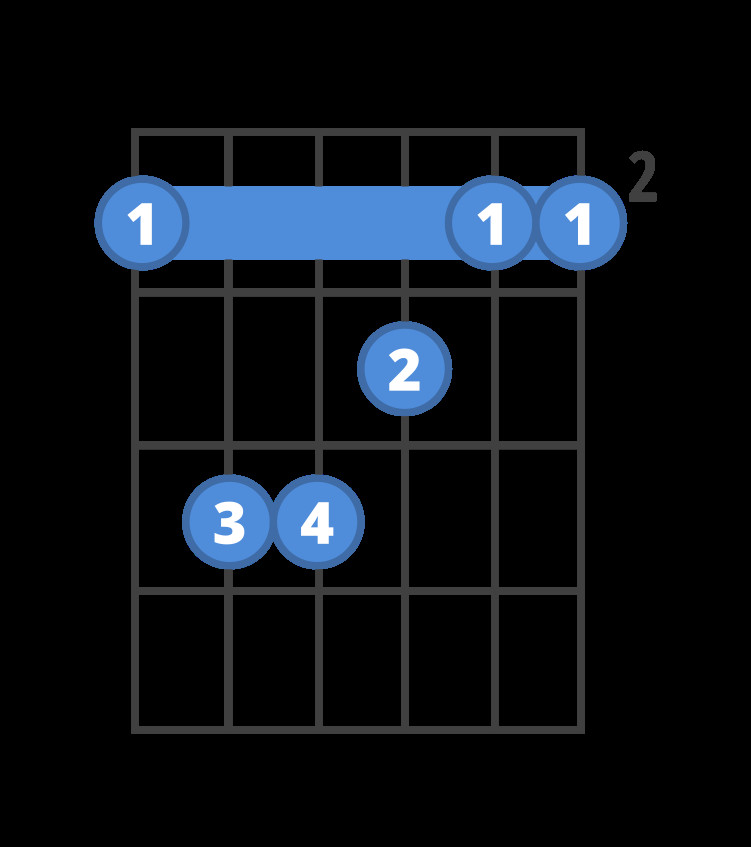 Chord diagram for the F# guitar chord.
Chord diagram for the F# guitar chord.
Think of this F# chord shape as an E major chord moved up two frets. Your index finger acts as a “capo,” barring across all six strings at the 2nd fret. Your remaining fingers then form the E major shape just behind the barre.
Here’s how to form the standard F# barre chord:
- Index Finger Barre: Place your index finger across all six strings at the 2nd fret. Ensure your finger is just behind the fret, and use the side of your finger for maximum pressure and clarity. You need to apply enough pressure to make all strings ring out clearly.
- Middle Finger: Place your middle finger on the 3rd fret of the G string (3rd string).
- Ring Finger: Place your ring finger on the 4th fret of the A string (5th string).
- Pinky Finger: Place your pinky finger on the 4th fret of the D string (4th string).
- Strum: Strum all six strings.
It’s common for beginners to experience buzzing or muted strings when first attempting barre chords. This is usually due to insufficient pressure from the index finger or incorrect finger placement. Don’t get discouraged! With practice and attention to technique, you’ll be playing clean F# barre chords in no time.
Tips for Mastering the F# Barre Chord
Playing barre chords effectively takes practice and attention to detail. Here are some key tips to help you master the F# barre chord:
- Focus on Index Finger Pressure: The index finger is crucial for a clean barre chord. Concentrate your pressure on the thicker E string (6th string) and the thinner E string (1st string). You can slightly roll your finger to use the bonier side for better leverage.
- Finger Placement: Ensure your fingers are positioned just behind the frets. This requires less pressure to produce a clear sound.
- Elbow Position: Experiment with your elbow position. Bringing your elbow slightly closer to your body can increase the strength of your barre.
- Think E Major Shape: Remind yourself that this barre chord is based on the E major shape you might already know. This mental connection can help you position your fingers correctly.
- Start Slowly: Practice transitioning to the F# barre chord from easier chords like E major or even open chords. Focus on getting a clean sound before increasing speed.
- Check for Buzzing: If you hear buzzing, identify the string(s) causing the problem. Usually, it’s a string not being pressed down firmly enough by your index finger. Adjust your pressure and finger position until the buzz disappears.
- Take Breaks: Barre chords can be tiring for your fretting hand, especially when you’re starting. Take breaks to avoid strain and maintain good practice habits.
The Easier F# Chord for Beginners: The Small Barre Version
If the full barre F# chord feels too challenging right now, especially if you are a beginner, there’s an easier version that still sounds great and allows you to play the F# chord without excessive finger strain. This version utilizes a smaller barre and involves fewer strings, making it much more accessible.
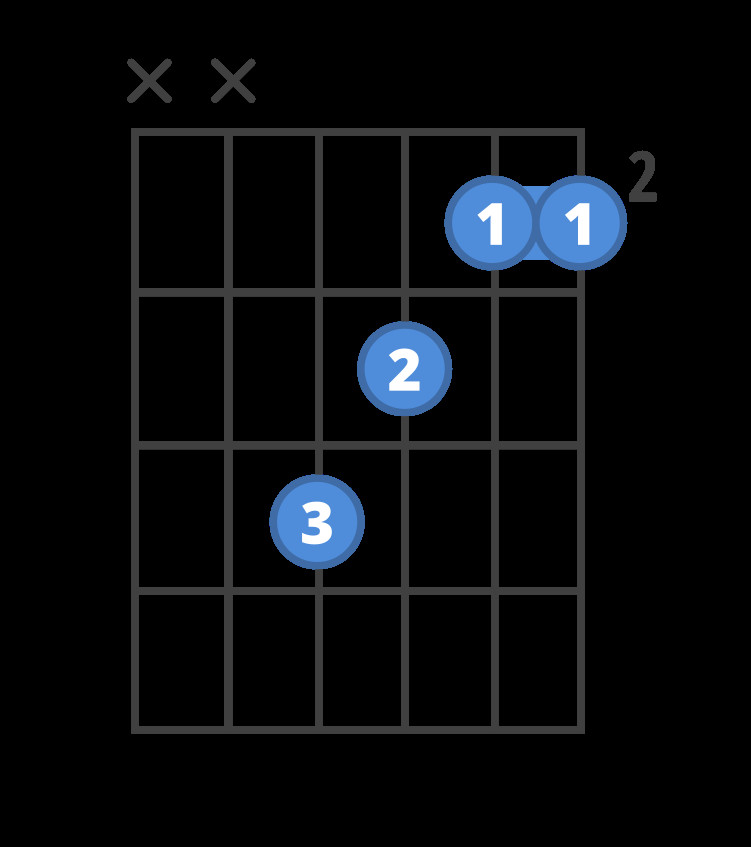 Chord diagram for the easier F# guitar chord.
Chord diagram for the easier F# guitar chord.
This beginner-friendly F# chord still incorporates a barre, but it’s a “mini-barre” across just the top two thinnest strings. This significantly reduces the hand strength required and makes achieving a clean sound much easier.
Here’s how to play the easier F# chord:
- Small Barre: Barre your index finger across the thinnest two strings (1st and 2nd strings – E and B strings) at the 2nd fret. Focus the pressure on these two strings.
- Middle Finger: Place your middle finger on the 3rd fret of the D string (4th string).
- Ring Finger: Place your ring finger on the 4th fret of the G string (3rd string).
- Strum: Strum only the thinnest four strings (from the D string down to the high E string). Avoid strumming the lower E and A strings for this voicing.
This version of the F# chord is perfect for beginners because it requires less finger strength and coordination. It still provides a full and rich F# major sound while being significantly easier to play. It’s an excellent stepping stone to the full barre chord and a viable option even for more experienced players in certain musical contexts.
Step-by-Step for the Small Barre F# Chord
Let’s break down the easier F# chord into simple steps:
-
The Mini Barre: Focus on creating a solid barre with your index finger across just the high E and B strings at the 2nd fret. Imagine you’re only trying to fret these two strings cleanly.
-
Adding Fingers: Once your mini-barre is secure, add your middle finger to the 3rd fret of the D string and your ring finger to the 4th fret of the G string.
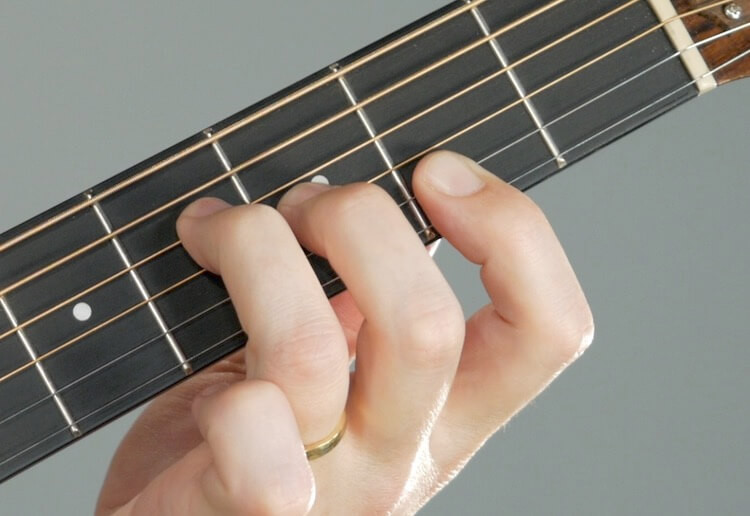 Close-up image of fingers forming the easier F# chord.
Close-up image of fingers forming the easier F# chord.
- Strumming the Right Strings: Be mindful to only strum the top four strings – D, G, B, and high E. Strumming the lower strings will muddy the sound of this particular voicing of the F# chord.
Practice Routines to Solidify Your F# Chord
Consistent practice is key to mastering any guitar chord, and the F# chord is no exception. Here are some effective practice routines to help you get comfortable with both versions of the F# chord:
1. Chord Transitions: E Major to F# Major (Barre)
Practice switching between the open E major chord and the full barre F# major chord. This exercise helps you internalize the relationship between the two shapes and build finger dexterity for barre chords.
E Major:
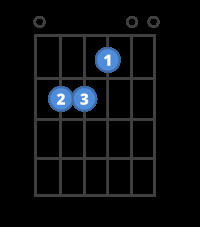 Chord diagram for the E guitar chord.
Chord diagram for the E guitar chord.
F# Major (Barre):
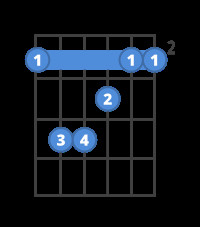 Chord diagram for the F# guitar chord.
Chord diagram for the F# guitar chord.
Practice transitioning smoothly back and forth between these two chords. Start slowly and gradually increase your speed as you become more comfortable.
2. Similar Shapes: F# Major to B Minor (Barre)
The B minor (Bm) chord uses the same barre chord shape as F# major, but shifted down one string set. Practicing transitions between F# and Bm helps you become more familiar with moving barre chord shapes around the fretboard.
F# Major (Barre):
 Chord diagram for the F# guitar chord.
Chord diagram for the F# guitar chord.
B Minor (Barre):
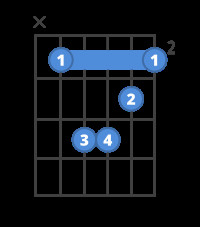 Chord diagram for the Bm guitar chord.
Chord diagram for the Bm guitar chord.
Practice switching between these chords, focusing on maintaining a clean barre and smooth transitions.
3. Chords in the Key of B Major: F#, E, B, and C#m
The F# chord is commonly found in the key of B major. Practice transitioning between F#, E, B major, and C# minor chords to get a feel for how F# fits into common chord progressions.
F# Major (Barre):
 Chord diagram for the F# guitar chord.
Chord diagram for the F# guitar chord.
E Major:
 Chord diagram for the E guitar chord.
Chord diagram for the E guitar chord.
B Major:
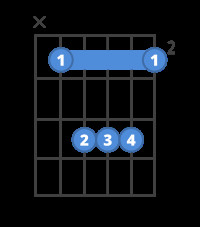 Chord diagram for the B guitar chord.
Chord diagram for the B guitar chord.
C# Minor:
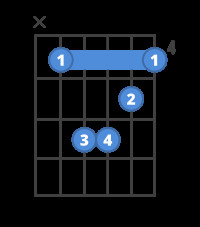 Chord diagram for the C#m guitar chord.
Chord diagram for the C#m guitar chord.
Practice these four-chord progressions to improve your chord changes and musicality.
Make Practice Fun with Games and Flashcards
To make your F# chord practice more engaging and effective, consider using interactive tools like ChordBank’s games and smart flashcards.
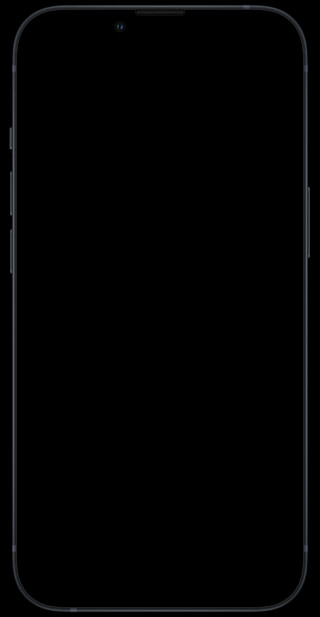 iPhone displaying ChordBank Smart Flashcards.
iPhone displaying ChordBank Smart Flashcards.
Smart Flashcards: ChordBank’s Smart Flashcards listen to you play and automatically advance when you play the correct chord. This is a fantastic way to build muscle memory and quickly internalize the F# chord.
Guitar Games: Games like ChordPOP! and Blast-o-chords turn chord practice into fun and rewarding experiences. ChordBank uses your iPhone’s microphone to react to your playing, making practice feel more like a game than a chore.
 iPhone displaying ChordBank Smart Flashcards.
iPhone displaying ChordBank Smart Flashcards.
Explore ChordBank Games and Flashcards for F# Chord Practice:
Practice E and F# with Smart Flashcards
Practice F# and Bm with Smart Flashcards
Practice F#, E, B, and C#m with Smart Flashcards
Play ChordPOP! with F#, E, and Bm
Play Blast-o-chords with F#, Bm, E, and C#m
Conclusion
The F Sharp Chord In Guitar, whether played as a full barre chord or the easier beginner version, is a valuable addition to any guitarist’s toolkit. Mastering the F# chord opens doors to playing a wider range of songs and understanding more complex musical concepts.
Start with the easier version if barre chords are new to you, and gradually work towards the full barre F


